Related Research Articles
In the broader context of racism against Black Americans and racism in the United States, mass racial violence in the United States consists of ethnic conflicts and race riots, along with such events as:

Brooks County is a county located in the U.S. state of Georgia, on its southern border with Florida. As of the 2020 census, the population was 16,301. The county seat is Quitman. The county was created in 1858 from portions of Lowndes and Thomas counties by an act of the Georgia General Assembly and was named for pro-slavery U.S. Representative Preston Brooks, after he severely beat abolitionist Senator Charles Sumner with a cane for delivering a speech attacking slavery.
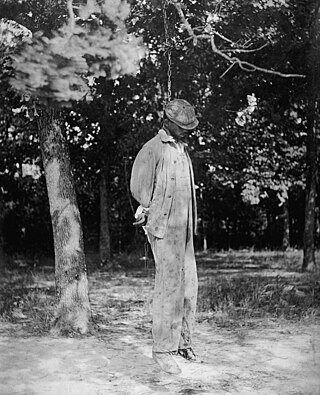
Lynching is an extrajudicial killing by a group. It is most often used to characterize informal public executions by a mob in order to punish an alleged transgressor, punish a convicted transgressor, or intimidate people. It can also be an extreme form of informal group social control, and it is often conducted with the display of a public spectacle for maximum intimidation. Instances of lynchings and similar mob violence can be found in every society.
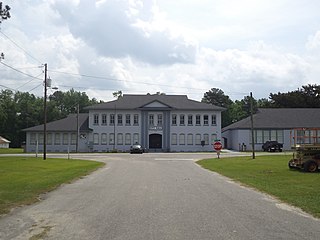
Morven is a city in Brooks County, Georgia, United States. It is part of the Valdosta metropolitan statistical area. The city was named after a mountain in Scotland. The population was 565 at the 2010 census, and 506 in 2020. It was formerly known as Sharpe's Store.

Valdosta is a city in and the county seat of Lowndes County, Georgia, United States. As the principal city of the Valdosta metropolitan statistical area, which in 2021 had a metropolitan population of 149,590, it includes Brooks County to the west. With a city population of 55,378 in 2020, Valdosta is the home of Valdosta State University, a regional university in the University System of Georgia with over 12,000 students.

Shubuta is a town in Clarke County, Mississippi, United States, which is located on the eastern border of the state. The population was 441 as of the 2010 census, down from 651 at the 2000 census. Developed around an early 19th-century trading post on the Chickasawhay River, it was built near a Choctaw town. Shubuta is a Choctaw word meaning "smokey water".
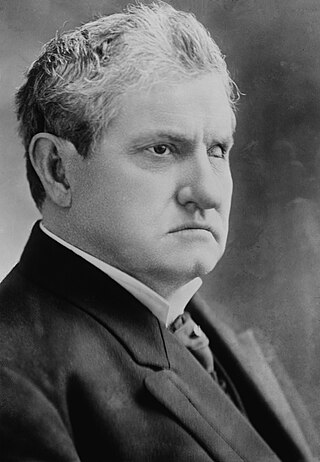
Benjamin Ryan Tillman was a politician of the Democratic Party who served as governor of South Carolina from 1890 to 1894, and as a United States Senator from 1895 until his death in 1918. A white supremacist who opposed civil rights for black Americans, Tillman led a paramilitary group of Red Shirts during South Carolina's violent 1876 election. On the floor of the U.S. Senate, he defended lynching, and frequently ridiculed black Americans in his speeches, boasting of having helped kill them during that campaign.
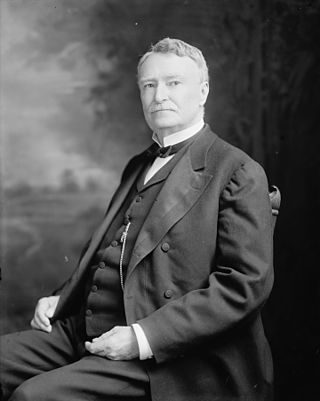
Anselm Joseph McLaurin was the 34th Governor of Mississippi, serving from 1896 to 1900.
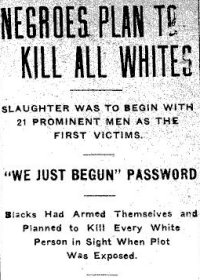
The Elaine massacre occurred on September 30–October 2, 1919 at Hoop Spur in the vicinity of Elaine in rural Phillips County, Arkansas. As many as several hundred African Americans and five white men were killed. Estimates of deaths made in the immediate aftermath of the Elaine Massacre by eyewitnesses range from 50 to "more than a hundred". Walter Francis White, an NAACP attorney who visited Elaine shortly after the incident, stated "... twenty-five Negroes killed, although some place the Negro fatalities as high as one hundred". More recent estimates in the 21st century of the number of black people killed during this violence are higher than estimates provided by the eyewitnesses, and have ranged into the hundreds. Robert Whitaker estimated 856 people were killed in his 2008 book on this topic. The white mobs were aided by federal troops and local terrorist organizations. Gov. Brough led a contingent of 583 US soldiers from Camp Pike, with a 12-gun machine gun battalion.
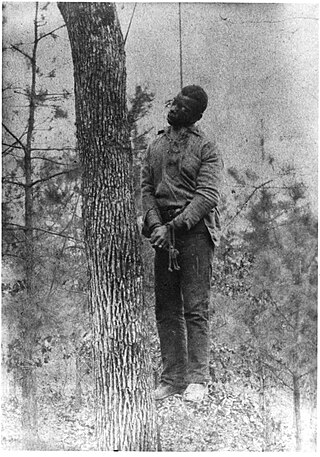
Lynching was the widespread occurrence of extrajudicial killings which began in the United States' pre–Civil War South in the 1830s and ended during the civil rights movement in the 1950s and 1960s. Although the victims of lynchings were members of various ethnicities, after roughly 4 million enslaved African Americans were emancipated, they became the primary targets of white Southerners. Lynchings in the U.S. reached their height from the 1890s to the 1920s, and they primarily victimised ethnic minorities. Most of the lynchings occurred in the American South, as the majority of African Americans lived there, but racially motivated lynchings also occurred in the Midwest and border states. In 1891, the largest single mass lynching in American history was perpetrated in New Orleans against Italian immigrants.

The 1906 Atlanta Race Massacre, also known as the 1906 Atlanta Race Riot, was an episode of mass racial violence against African Americans in the United States in September 1906. Violent attacks by armed mobs of White Americans against African Americans in Atlanta, Georgia, began after newspapers, on the evening of September 22, 1906, published several unsubstantiated and luridly detailed reports of the alleged rapes of 4 local women by black men. The violence lasted through September 24, 1906. The events were reported by newspapers around the world, including the French Le Petit Journal which described the "lynchings in the USA" and the "massacre of Negroes in Atlanta," the Scottish Aberdeen Press & Journal under the headline "Race Riots in Georgia," and the London Evening Standard under the headlines "Anti-Negro Riots" and "Outrages in Georgia." The final death toll of the conflict is unknown and disputed, but officially at least 25 African Americans and two whites died. Unofficial reports ranged from 10–100 black Americans killed during the massacre. According to the Atlanta History Center, some black Americans were hanged from lampposts; others were shot, beaten or stabbed to death. They were pulled from street cars and attacked on the street; white mobs invaded black neighborhoods, destroying homes and businesses.
On May 16, 1918, a plantation owner was murdered, prompting a manhunt which resulted in a series of lynchings in May 1918 in southern Georgia, United States. White people killed at least 13 black people during the next two weeks. Among those killed were Hazel "Hayes" Turner and his wife, Mary Turner. Hayes was killed on May 18, and the next day, his pregnant wife Mary was strung up by her feet, doused with gasoline and oil then set on fire. Mary's unborn child was cut from her abdomen and stomped to death. Her body was then repeatedly shot. No one was ever convicted of her lynching.

In Forsyth County, Georgia, in September 1912, two separate alleged attacks on white women in the Cumming area resulted in black men being accused as suspects. First, a white woman reportedly awoke to find a black man in her bedroom; then days later, a teenage white woman was beaten and raped, later dying of her injuries.
Joe Pullen or Joe Pullum was an African-American sharecropper who was murdered by a lynch mob of local white citizens near Drew, Mississippi on December 15, 1923.

Berry Washington was a 72-year-old black man who was lynched in Milan, Georgia, in 1919. He was in jail after killing a white man who was attacking two young girls. He was taken from jail and lynched by a mob.

The Jenkins County riot of 1919 took place on Sunday, April 13, 1919, two white police officers were killed at a traffic stop. In response, several buildings were burned in the black community and at least four people were killed.

The Johnson–Jeffries riots refer to the dozens of race riots that occurred throughout the United States after African-American boxer Jack Johnson defeated white boxer James J. Jeffries in a boxing match termed the "Fight of the Century". Johnson became the first black World Heavyweight champion in 1908 which made him unpopular with the predominantly white audience of boxing. Jeffries, a former heavyweight champion came out of retirement to fight Johnson and was nicknamed the "Great White Hope". After Johnson defeated Jeffries on July 4, 1910, many white people felt humiliated and began attacking black people who were celebrating Johnson's victory.

The Newberry Six lynchings took place in Newberry, Alachua County, Florida, on August 18, 1916.
The lynching of Henry Lowry, on January 26, 1921, was the murder of an African-American man, Henry Lowry, by a mob of white vigilantes in Arkansas. Lowry, a tenant farmer, had been on the run after a deadly shootout at the house of planter O. T. Craig on Christmas Day of 1920. Lowry went into hiding in El Paso, Texas; when he was discovered and extradited by train, a group of armed white men boarded the train in Sardis, Mississippi, and took Lowry to Nodena, near Wilson, Arkansas. He was doused in gasoline and burned alive before a mob of 500. A reporter from the Memphis Press witnessed the event, and word of the lynching soon spread around the country, aided by an article William Pickens wrote for The Nation, in which he described eastern Arkansas as "the American Congo".
Luther Holbert was an African American man who was tortured and lynched by a mob in Doddsville, Mississippi on Sunday, February 7, 1904, after being accused of a double murder. An African American woman who was with Holbert was also tortured and killed. Six other people were also killed during the search for Holbert and the woman.
References
- ↑ Brundage, W. Fitzhugh. Under Sentence of Death: Lynching in the South, pp. 261-62 (2017)
- ↑ Race War in Georgoa, The Literary Digest (January 5, 1895)
- ↑ Appletons' Annual Cyclopaedia and Register of Important Events, Volume 20, p. 313 (1896)
- ↑ (26 December 1894). The Brooks County War Is Ended, The New York Times
- ↑ (24 December 1894). Killed by the Mob, Sranton Tribune
- ↑ (24 December 1894). Seven Lives for One, Los Angeles Herald
- ↑ (26 December 1894). In a State of Alarm, Los Angeles Herald
- ↑ (26 December 1894). Rifles Ready, San Francisco Call
- ↑ (24 December 1894). Seven Colored Men Killed in a Riot Near Quitman, Baltimore Sun
- ↑ (4 January 1895). Georgia's War Ends, Pioneer Express (December 27 dateline article)
- ↑ (24 December 1894). Hunting Negroes Near Quitman, The New York Times
- ↑ Hearn, Daniel Allen . Legal Executions in Georgia: A Comprehensive Registry, 1866–1964, p. 58 (2015)